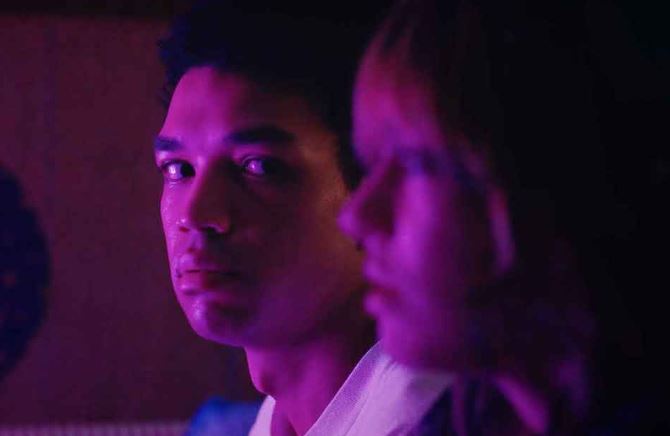Coming-of-age stories often follow a typical arc. A lonely youth, not accepted by their family and their social group, suffers through the pangs of rejection – but ultimately finds a suitable romantic partner, a loner themselves, and a fulsome and fulfilling life is projected outwards from that point. However, many of these stories only engage with the pain of adolescence as if it were a kind of picturesque life-stage.
Jane Schoenbrun’s first film, We’re All Going to the World’s Fair, was the rare movie that dealt with adolescent pain on its own terms. It’s a hopeless story about a teenage girl in America who finds some temporary companionship in a community of horror-obsessed freaks online. Not much happens in the film, except that her loneliness is ultimately reinforced. It could be categorised as a horror movie, but the only real monster in it is the terror of being completely isolated from your fellow human beings.
It’s a great movie, and one which really captures something about our moment, when people are probably lonelier than they have been at any other time in history. Schoenbrun’s latest film, I Saw the TV Glow, deals with similar themes, but is more ambitious in scope, shedding much of the realism of We’re All Going to the World’s Fair.
The protagonist, Owen (Justice Smith), is a boy living in an unhappy domestic situation in suburbia. He meets another outsider, Maddy (Brigette Lundy-Paine), who introduces him to a show called The Pink Opaque. The premise of The Pink Opaque is that two teenage girls, Isabel and Tara, meet at a summer camp and realise that they are psychically linked. Their mission is to battle the moon-man, Mister Melancholy, and his henchmen, Marco and Polo. However, they fight this battle with Mister Melancholy telepathically at long distance, from their homes in neighbouring counties.
It’s actually a great idea for a show, and I Saw the TV Glow plays on 90s nostalgia around similar shows which were very entertaining for children whilst also being a little bit adult. The credits of The Pink Opaque use the Buffy font, and Amber Benson, who played Tara in Buffy, has a cameo in the film. The idea of two people who are telepathically connected but never physically interact is also a great metaphor for the kinds of virtual communities that have proliferated in our era, and of which 90s fandom was an early example.
Owen and Maddy form a close friendship based around The Pink Opaque, with Maddy identifying herself with Tara and Owen with Isabel. Tara, she says, is the braver of the two. Maddy likes girls, while Owen says that he likes TV shows. He feels that something is wrong with him but, except for some indications that this indefinite “wrongness” has to do with his gender identity, he’s a mystery to himself.
As Maddy and Owen grow older, The Pink Opaque is cancelled. Maddy disappears, and Owen is left to make his way as an adult in a heartless world, until Maddy suddenly reenters his life and tells him that The Pink Opaque really was more than a TV show, that she is actually Tara, and Owen is Isabel, and they are both prisoners in a fake world created by Mister Melancholy. Maddy claims to know how they can escape it and return to their real lives as the protagonists of The Pink Opaque.
Schoenbrun establishes a potent atmosphere from the first scene of the film, with most of it taking place at night or in the early evening. The film’s slow pace perfectly captures the languor of adolescence, that feeling of waiting around for something that is never going to show up. Schoenbrun wisely shows us as little of The Pink Opaque as possible, and for the most part uses visual effects sparingly, except for one genuinely unsettling sequence depicting the brutal “last episode” of the show. For the most part I wouldn’t describe I Saw the TV Glow as a horror movie per se, but it has a real sense of the uncanny, greatly aided by Schoenbrun’s distinctive visual style. The film also has a fantastic indie soundtrack – clearly a passion of the director.
However, as is often the case for stories reliant on ambiguity, Schoenbrun does not quite stick the ending. One would not expect (or want) the plot to have a neat resolution, but the ending does not really satisfy on a psychological or emotional level either. Lee Chang-dong’s Burning (2018) is a great example of a film that maintains ambiguity right up until the credits roll, but does not leave the audience unsatisfied. With I Saw the TV Glow, however, I felt as if Schoenbrun was at something of a loss for how to bring things to a close.
Like We’re All Going to the World’s Fair, I Saw the TV Glow is a sad movie, almost desperately so. And although the film’s ambiguity perhaps holds out some hope, it is deeply pessimistic about the ability of virtual communities to provide solace for a life spent alone on the computer or in front of the television. It is refreshing to see a film with such a clear-eyed — at times, painfully honest — angle on its subject matter. Schoenbrun has clearly found their theme, and they treat it with all the seriousness it deserves.
I Saw the TV Glow opens in select Australian cinemas tomorrow, going wider in September.



